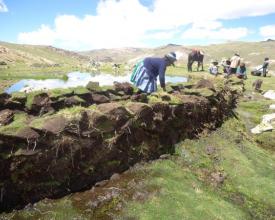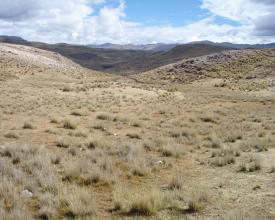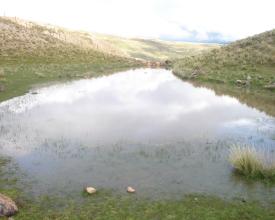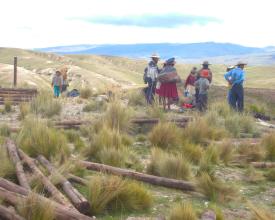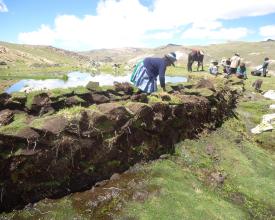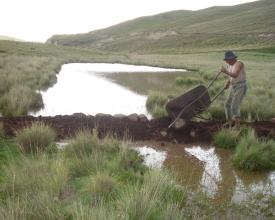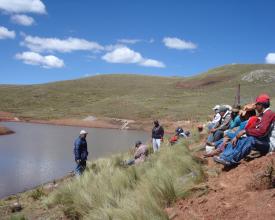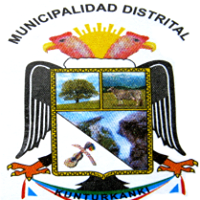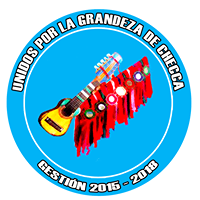
Planting and harvesting rainwater in the Huacrahuacho micro-watershed in the face of drought
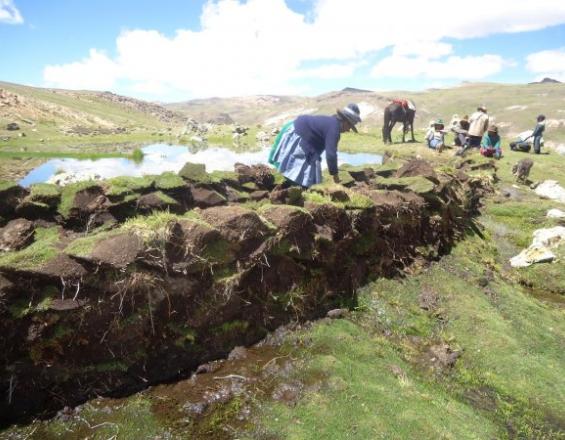
This solution was implemented in the Huacrahuacho micro-watershed, located in a high Andean ecosystem called Puna above 3,800 meters above sea level. It was designed to address the problems of drought and reduction of water sources during the dry season for human consumption and agricultural and livestock use. Its objectives were to capture, store and infiltrate water and recharge the aquifers; increase/maintain the flow of springs; generate a microclimate with higher humidity; and conserve biodiversity.
The qocha, a Quechua word meaning small lagoon, was the focus of a set of measures incorporating afforestation, infiltration ditches, natural pasture management and collector or adductor ditches.
Thanks to these measures built by the families and at the communal level, there is more water during the dry season, which has allowed the recovery of natural pastures for livestock production and a change towards a more humid landscape with greater biodiversity and scenic beauty.
Context
Challenges addressed
- Climate change. Cusco is a region with very dry periods that, with climate change, are increasing in number of dry days and on the other hand, rainy days are more intense.
- Governance of natural resources. One obstacle has been and continues to be the land tenure pattern in the area. The excessive parcelization and number of families involved requires a very intensive level of negotiation.
-
Involvement of other stakeholders. The qochas are generally located in the headwaters of the watershed and, in this particular case, in the upper parts of the streams. While it is true that qocha owners or users can benefit directly from the qocha's area of influence, there are also families living further downstream of these systems who benefit and yet their collaboration has not yet been achieved.
Location
Process
Summary of the process
The methodology of contests in the area of planting and harvesting water (BB1), allowed the mobilization, training and technical assistance to implement technologies contributing to the construction of qochas (or rustic dams) in addition to other structural and non-structural measures (BB2). To identify and confirm the hydrological benefits of these components, a hydrogeological study of the functioning of the qochas was carried out (BB3).
Building Blocks
Mobilization: Water planting and harvesting contest
The contests, developed at the family and community level, were designed to motivate the implementation of technologies for adaptation to climate change, taking advantage of the culture of healthy competition and family and collective work that exists in rural communities.
The communities and/or families that participated received advice and technical support throughout the process, generating technical capacities for the proper management of natural resources and productive activities, with the focus on increasing the water retention and recharge capacity of the micro-watersheds and contributing to food security.
The families were motivated to demonstrate good practices, which opens the door to local recognition by the population and public and private institutions. During the contests, each family or group carried out activities for the habilitation or improvement of the qochas, such as: elaboration of a talking map, construction of a dam, delimitation of the tributary area (upstream) and area of influence (downstream) of the qocha, rustic collector or feeder canals and infiltration ditches.
Enabling factors
- Community organizations committed to group work demonstrations.
- Advisory institutions and farmer promoters are required to disseminate the practice appropriately.
- Building confidence in the usefulness of the implementation of the measures through appropriate communication of the benefits.
- Involvement of local government with specific resources
- The demand for water, a felt need in the community.
- Initial motivation is key, starting with showing that these practices "work" with previous cases.
Lesson learned
- Motivation is important to implement the practices since they are labor-intensive. The contests reinforce the interest of farming families in the implementation with the incentive of obtaining public recognition that could give them access to other incentives.
- The direct advisory action is facilitated during the contest, it is a way to learn by doing and to promote more knowledge for the implementation of this measure, and complementary measures (reseeding of pastures, infiltration ditches, afforestation, pasture protection, etc.).
- In the end, the families are satisfied to see the results of change in their land, beyond winning or not some recognition, the family keeps the work done through the contest because they are aware of the benefits. Their land acquires greater value (reduction of vulnerability).
- This methodology is assimilated by the local authorities, who incorporate the modality in their strategies to promote good agro-productive practices, linking these strategies to small irrigation projects.
Practical: Construction of rustic dams or dams: structural and natural measures
The qochas are built by taking advantage of natural depressions in the ground or natural lagoons, constructing a dam to increase the level of the dammed water and therefore capture and store more water from rainfall. Three types of qochas are identified :
1. Water harvesting qochas, used to store water superficially, thanks to their impermeable base and edges.
Water planting qochas, which store water for a short time thanks to their permeable base. The stored water infiltrates and recharges the subsoil and local aquifers.
3. The qochas for planting and harvesting water (mixed): they have both characteristics due to their semi-permeable characteristics.
Structural components: earth, clay and champas dams, the spillway with its overflow ditch, and the collector or adduction channel (where required).
Non-structural components/green measures: complement the qocha forming an integrated system. Conservation of natural grasses, afforestation and reforestation with native species, and infiltration ditches.
Enabling factors
- Land tenure security.
- Agreement of the population to use their land to carry out the practices, especially to implement multi-family or communal qochas. In some cases, use restriction zones were even declared to facilitate the implementation of the practices.
- Certainty of obtaining water benefits for the families working the qochas, which may come from local knowledge or hydrogeological studies.
-
Availability of local labor.
Lesson learned
- The construction of qochas cannot be conceived only as an individual or family effort at the level of scattered agricultural plots, since a territorial approach is required that involves comprehensive and "tailor-made" actions at the level of families, groups and community organizations.
- A comprehensive analysis of the problems of the micro-watershed and the incorporation of the qocha construction measure as part of the intervention strategies at a larger level is required. The experience of implementing the qocha construction measure, as the axis of other practices (closure and replanting of pastures, agroforestry or construction of infiltration ditches) in Huachrahuacho, reinforced the conviction that this is a win-win measure. Thus, this measure was incorporated into: a public investment project in four communities in the Cusco Region, the National Program for Planting and Harvesting Water and the National Hakuy Wiñay Program.
- The qochas work synergistically with other measures or practices such as infiltration ditches, pasture protection, reforestation, among others.
Evidence: Hydro-geological study of qochas functioning.
The experience was complemented with the hydrogeological study of the functioning of the qochas and pastures in the recharge of aquifers in the Huacrahuacho micro-watershed. For this purpose, monitoring was carried out by analyzing the isotopic concentrations of Deuterium (H2) and Oxygen 18 (O18), which allows determining the dynamics of the water masses in the subsoil, including the interrelation between the reservoirs (qochas) and the springs in the nearby areas. The study was conducted by the Peruvian Institute of Nuclear Energy (IPEN). It also mentions the benefits of recovering diversity (agrostological variety), improving the beauty of the landscape, revaluing traditional knowledge, and strengthening the organization. This information was disseminated through communication strategies aimed at the local population to motivate continuity in the implementation of the actions.
Enabling factors
- Be clear about the indicators of hydrological benefits, for example, the regulation of base flows in springs in the lower part.
- The support of an institution specialized in the subject is necessary, since it is necessary to have the capacity and credibility to be able to gather the evidence.
- In order to record information in situ , it is necessary to count on skilled and trained people from the area; in this case, the action of the promoters or peasant leaders of the area, called kamayoc (Quechua term).
Lesson learned
- Hydrological monitoring makes it possible to verify the effectiveness of water recharge practices.
- A hydrogeological monitoring system requires a control network in various upwelling zones, since there is no single recharge site.
- The monitoring system makes it possible to identify areas conducive to recharge, but also to rule out places and practices that do not favor water recharge.
- It was very important to have partnerships with local research institutions that could develop the required studies.
- In several cases, the scientific studies corroborated the perceptions of the villagers regarding water flow; however, it was not always possible to identify where the water from an infiltration qocha will emerge, nor is it possible to predict precisely how long it will take for it to emerge.
- An appropriate system for communicating the results of monitoring and evaluation is needed to motivate the implementation of the actions being promoted.
Impacts
Environmental:
- Aquifer recharge. A study concluded that the waters of some qochas contribute to the recharge of the aquifers that feed the flows of the water sources.
- The microclimate in the area around the qocha is moderated, favoring the recovery of vegetation cover.
- Natural pastures have recovered and palatable species for livestock have reappeared, at least in those sites that have been fenced and closed for controlled grazing.
- Biodiversity and scenic beauty have been recovered.
Socio-economic:
-
Livestock being the main livelihood of families, improved pastures contribute to improved family incomes. The "green structures" are areas of food and water for livestock during the dry season. From the families' point of view, by improving these structures, the animals maintain their weight better and milk production increases, with which they produce cheese, which fetches a good price in the local and regional market.
-
This contributes to the families' food security and income diversification.
Socio-cultural:
- Traditional cultural practices have been recovered and conflicts over water have been reduced.
Beneficiaries
- 135 families directly involved in the implementation of the qochas.
- 800 families in the Huacrahuacho micro-watershed.
Sustainable Development Goals
Story
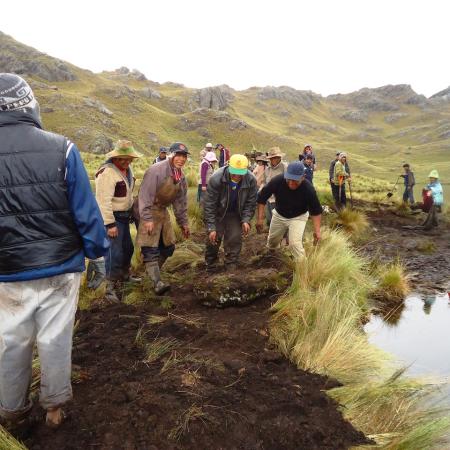
The Climate Change Adaptation Program (PACC) PERU, between 2014 to 2016, implemented through inter-family and group contests 135 family qochas and 11 communal qochas for planting and harvesting water, in 16 communities. The qochas stored a total of 74,991 m3 (74.9 million liters) of water for agro-productive uses and population consumption.
The following is part of a testimony extracted from "Yachaykusun". Andean teachings in the face of climate change" (MINAM et al. 2014):
"The Moroccacca qocha was born at altitude, brushing against the clouds, not for one, but for all. It belongs to the 150 families of the peasant community of Pucacancha, even though it is several hundred meters higher than the town center. It is a communal lagoon with the size of almost two and a half soccer fields, and the capacity of five Olympic-size swimming pools, although it could safely store twice as many, because it is not in a ravine. Moroccacca is not just any reservoir: it is at the headwaters of the Huacrahuacho micro-watershed, Cusco, at 4,373 meters above sea level. So, if you think about it, its water does not only belong to those above, but also to those living below. It was not easy to convince the community to build it, even though there was already a small q'ocha there. Before it was flooded, it was a green pasture where the alpacas were taken to feed, and where they also used to play soccer at two o'clock in the afternoon, after the cattle work. It was even less easy to explain to them that, due to the filtration, part of the water would end up downhill, far from their land".
Testimony of Samuel Huarca, then president of the Pucacancha CC, who participated in the first class of Climate Change Leader Training.
Flavio Valer, a specialist in Local Adaptive Responses of the Climate Change Adaptation Program in Cusco, adds: "Then we considered something more comprehensive: in addition to building dams and digging infiltration ditches, the land had to be fenced and forested. This is what they did with the hills surrounding Moroccacca. All the community members of Pucacancha worked on the enclosure of 54 hectares, with logs and wire mesh. The alpacas would no longer be allowed to graze. They also began planting native tree species such as the queñua, which uses 5% of the water of a eucalyptus tree, the qolle, and the qishuar, the sacred tree of the Incas".
